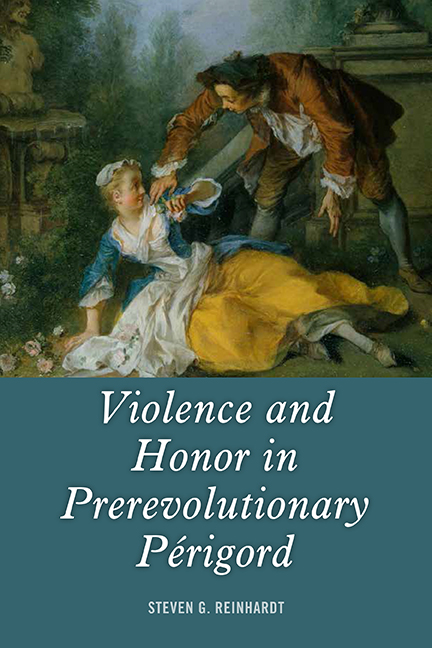Book contents
- Frontmatter
- Dedication
- Contents
- Acknowledgments
- Maps
- Introduction: “The Saint of Honor”
- 1 Violence and Honor
- 2 Honor in a Cross-Cultural Context
- 3 From Honor to Honnêteté in Old Regime Europe
- 4 “The Good Old Days” in Prerevolutionary Sarladais
- 5 “The Saint of Honor” in the Sénéchaussée of Sarlat
- 6 Women and Honor-Related Criminal Affaires
- 7 Policing Honnêteté: Shameful, Sinful, and Criminal Conduct
- 8 “Fallen Women” and Infanticide
- 9 Compromised Honor and Dangerous Liaisons
- 10 Honor and Homicide
- Conclusion
- Notes
- Bibliography
- Index
3 - From Honor to Honnêteté in Old Regime Europe
Published online by Cambridge University Press: 10 June 2021
- Frontmatter
- Dedication
- Contents
- Acknowledgments
- Maps
- Introduction: “The Saint of Honor”
- 1 Violence and Honor
- 2 Honor in a Cross-Cultural Context
- 3 From Honor to Honnêteté in Old Regime Europe
- 4 “The Good Old Days” in Prerevolutionary Sarladais
- 5 “The Saint of Honor” in the Sénéchaussée of Sarlat
- 6 Women and Honor-Related Criminal Affaires
- 7 Policing Honnêteté: Shameful, Sinful, and Criminal Conduct
- 8 “Fallen Women” and Infanticide
- 9 Compromised Honor and Dangerous Liaisons
- 10 Honor and Homicide
- Conclusion
- Notes
- Bibliography
- Index
Summary
Before examining how honor and violence interacted in the late eighteenthcentury Sarladais, we must first consider how European honor culture changed during the early modern period. Honor was an important facet of European culture that encompassed a set of values and practices reflecting society's evolving relationship to its material world. The transformation of traditional honor culture, therefore, occurred in tandem with the fundamental developments that were gradually transforming western Europe into a modern society of contract: the internal dynamic of state building, the monopolization of violence in the hands of royal justice, the spread of capitalism and capitalist relations, the extension and consolidation of Christian (Protestant and Catholic) worship, and the intellectual revolution of the Enlightenment. Cultural adaptations may have occurred first among the “legal community” of professionals, as well as among artisans, tradesmen, and shopkeepers (called “the middling sort” in English towns), but they also occurred (to a lesser degree) among property owners and sharecroppers in the countryside that initially rested on an agrarian base designed more for continuity than for change. But here, too, the cultural consequences were profound. As the early modern world slowly underwent structural modification, its understanding of honor also evolved.
Gestures and Words
Violence was an ordinary part of interpersonal relations in Old Regime society and naturally found expression in words and gestures that have long fascinated scholars. Within recent decades, historians of early modern Europe have paid increasing attention to their importance. Scholars can confirm that by the late medieval period, ritual gestures, formal words, and symbolic objects were vital aspects of interpersonal relations. A new concept of civilité was beginning to emerge and became apparent by 1530, when Erasmus of Rotterdam wrote a short treatise in which he called for the reform of “outward bodily propriety”—especially people's dress, facial expressions, table manners, and gestures—which he considered to be “expressions of the inner, whole man.” In the seventeenth century, scholars and artists subsequently became even more interested in the “language” and “grammar” of gestures. They commented on the variety of cultures that seemed to distinguish, for example, the reserved English from the more effusive and gesticulating French and Italians. This new interest in symbolic interaction was a logical extension of the sixteenthcentury “reform of gestures” that reinforced the overall “evolution of manners” most pronounced in the courts of Italy.
- Type
- Chapter
- Information
- Violence and Honor in Prerevolutionary Périgord , pp. 46 - 70Publisher: Boydell & BrewerPrint publication year: 2018

